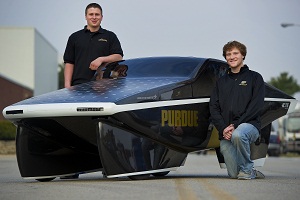Purdue to race solar car in Shell Eco-Marathon
 The Purdue University solar car team will have the only solar-powered vehicle entered in the urban class competition at the Shell Eco-Marathon later this week.
The Purdue University solar car team will have the only solar-powered vehicle entered in the urban class competition at the Shell Eco-Marathon later this week.
Shell’s Eco-Marathon has been rewarding high school and college students for breaking fuel efficiency records since 1939, when students created a car that got 50 miles to the gallon. Now, the standard is in the thousands, and students can typically drive their homemade cars from coast to coast on the equivalent of a gallon of gas, according to press material about the race.
The race has two classes—one for prototype cars that are designed to be as efficient and fast-moving as possible and another for urban cars. Urban cars are designed to be functional and operate much like modern cars today but with wildly outrageous fuel efficiencies.
Purdue’s team has been building solar cars since 1991, said team president senior Ted Pesyna.
“We wanted to do something kind of different with our entry this year,” Pesyna said. “The concept was to design a solar vehicle that’s not only efficient but something we could also take to the next level, something that people can look at and see it taking them to the grocery store.”
That’s what the Celeritas2 is. It’s not just a futuristic zero-emissions, thousands-of- miles-to-the-gallon vehicle. It’s also a car.
Granted, it only ways 325 pounds and looks pretty futuristic, covered in 220 solar cells and with just enough room for two people inside. But it does still carry the likeness of a regular old car.
Pesyna explains how it’s driven in a tone that lets you know not all of the Shell Eco-Marathon entries will be this way.
“The driver sits upright in the vehicle,” Pesyna said. “There’s an acceleration pedal and a brake pedal and a steering wheel.”
What he described seems like what you would expect from a car, which is why the team built it that way.
The team used top-of-the-line terrestrial grade solar cells to power the car. They reach peak efficiencies of about 20 percent, Pesyna said. It’s also equipped with advanced batteries that will absorb extra energy and be able to power the car in the event of clouds, rain or darkness. The batteries can also be removed to lighten the car’s load.
Inside, about five different computer systems, also powered with the solar cells, monitor the cars energy intake, use and storage.
“If there was ever a problem with the car, we would know,” Pesyna said. “And we would be able to use the systems to diagnose it before it became a major problem.”
Pesyna is a senior. This is the third solar car he has worked on. The team builds new cars in two-year cycles so that every class gets a chance to see a project through from beginning to end. There are about 40 dedicated Purdue students on the team, Pesyna said.
He’s excited to see how the Ceritas2 fares as the only solar-powered car in the urban class this week.
Image courtesy of Purdue Solar Racing.



